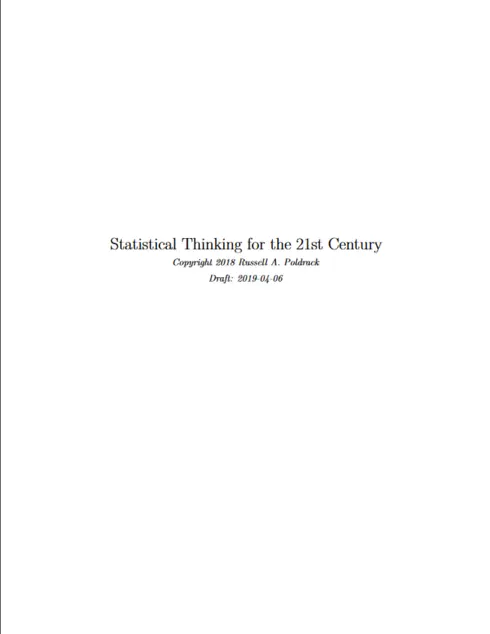
Statistical Thinking for the 21st Century
![]()
![]()
![]()
![]()
![]()
Russell A. Poldrack, Stanford University
Copyright Year:
Publisher: Russell Poldrack
Language: English
Formats Available
Conditions of Use
![]() Attribution-NonCommercial
Attribution-NonCommercial
CC BY-NC
Reviews
Reviewed by Sage Bushman, Faculty Tutor, Rogue Community College on 8/25/25
This textbook would be very beneficial for an introductory statistics student. read more
![]()
![]()
![]()
![]()
![]()
Reviewed by Sage Bushman, Faculty Tutor, Rogue Community College on 8/25/25
Comprehensiveness
This textbook would be very beneficial for an introductory statistics student.
Content Accuracy
Based on my experience teaching and tutoring statistics, the accuracy of this textbook is nothing to worry over. The information is true and clear.
Relevance/Longevity
This text is up-to-date with statistical analysis of the 21st century being the main focus. It will mot be difficult to update the information in this textbook if ever necessary.
Clarity
This is a great textbook for students providing clear instruction for those who are newer to statistics.
Consistency
The terminology and subject matter is consistent throughout the entirety of this textbook.
Modularity
You can easily break this textbook down into smaller segments for both the students and teachers.
Organization/Structure/Flow
This textbook is organized in such a way to provide ease of use by both students and teachers.
Interface
This text is free of significant interface issues that could cause readability errors or difficulties that could cause student and teacher confusion.
Grammatical Errors
I did not come across any grammatical errors while skimming through this textbook.
Cultural Relevance
I found this text to be culturally sensitive and provided a variety of examples.
Reviewed by Larry Leemis, Professor, William & Mary on 12/20/19
This review concerns an incomplete draft of the book dated 12-9-2019. Although this appears to be a textbook for a college course directed at psychology students enrolled in a statistics course, there are no homework exercises, nor is their an... read more
![]()
![]()
![]()
![]()
![]()
Reviewed by Larry Leemis, Professor, William & Mary on 12/20/19
Comprehensiveness
This review concerns an incomplete draft of the book dated 12-9-2019. Although this appears to be a textbook for a college course directed
at psychology students enrolled in a statistics course, there are no homework exercises, nor is their an index at this point in time.
There are numerous omissions, typographical errors, etc. in this draft. The book appears to have potential as a textbook once completed. The
author is using R as a platform for data visualization and modeling, which is an appropriate choice for the material being presented.
Content Accuracy
The draft of the textbook contains numerous errors and omissions.
Relevance/Longevity
The author uses up-to-date examples. He tends to prefer the use of packages in R rather than the functions in the base language (for example, using
a tibble rather than a standard data frame). The content is modular, which means that chapters can be easily updated.
Clarity
In the chapters which are complete, the presentation is lucid.
Consistency
Statistical methods tend to have an ad hoc nature, which means that it is difficult to have notation that remains consistent throughout.
Chapters are often paired, with an introductory chapter covering the statistical method followed by a chapter on the implementation in R,
which is helpful. The author does well in presenting statistical concepts without the benefit of a strong mathematical foundation.
Modularity
The chapters are largely self-contained. It will be difficult for students who are new to the R language to generalize their understanding
of the functions to a more general setting from just an example or two.
Organization/Structure/Flow
The pairing of the chapters (for example, Chapter 12 is titled Sampling and Chapter 13 is titled Sampling in R) should be helpful
for the students in order to separate the statistical technique from its implementation.
Interface
The author appears to have written the draft in LaTeX. Some of the font sizes on labels on figures should be adjusted so that they are
close to the font size in the text when possible. Lines of code currently run off of the page, which I assume will be corrected in
the future.
Grammatical Errors
The author is clearly a good writer. Once the draft gets completed, the typos removed, exercises written, and an index generated, this
book would be appropriate as a college-level statistics text for psychology students.
Cultural Relevance
The author does not limit the discussion to just psychology applications. Examples ranging from 2017 election results to Steph Curry free throw results are included.
Table of Contents
- 1 Introduction
- 2 Working with data
- 3 Probability
- 4 Summarizing data
- 5 Fitting models to data
- 6 Data Visualization
- 7 Sampling
- 8 Resampling and simulation
- 9 Hypothesis testing
- 10 Confidence intervals, effect sizes, and statistical power
- 11 Bayesian statistics
- 12 Modeling categorical relationships
- 13 Modeling continuous relationships
- 14 The General Linear Model
- 15 Comparing means
- 16 The process of statistical modeling: A practical example
- 17 Doing reproducible research
About the Book
Statistical thinking is a way of understanding a complex world by describing it in relatively simple terms that nonetheless capture essential aspects of its structure, and that also provide us some idea of how uncertain we are about our knowledge. The foundations of statistical thinking come primarily from mathematics and statistics, but also from computer science, psychology, and other fields of study.
About the Contributors
Author
Russell A. Poldrack
